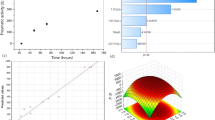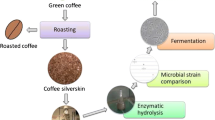Abstract
Extracellular β-glucosidase was produced using coffee pulp as a sole carbon source by Penicillium verrucosum by solid state fermentation and 897.36±59 U/g enzyme activity was obtained. Increase in 2.21-fold of enzyme activity on optimizing the bioprocess parameters by response surface methodology based on central composite rotatable design is illustrated. Maximum production level of 1,991.17 U/g was obtained with optimum values of pH 4.2, moisture 66.8%, and fermentation duration of 56 h. The enzyme was partially purified and the enzyme activity was optimum at 50°C temperature and at pH 6. The metal ions such as Mg2+, Zn2+, Ca2+, K+, detergents, and chelator such as EDTA were effective and further increased the β-glucosidase activity. On application of β-glucosidase for simultaneous saccharifiation and fermentation, 3.3% ethanol was obtained. Thus, this study provides insight on exploitation of P. verrucosum for synthesis of of β-glucosidase using coffee pulp which is available abundantly in coffee processing industries.
Similar content being viewed by others
References
Harnpicharnchai P, Champreda V, Sornlakea W, Eurwilaichitra L. A thermotolerant β-glucosidase isolated from an endophytic fungus Periconia sp., with a possible use for biomass conversion of sugars. Protein Expres. Purif. 67: 61–69 (2008)
Leite RSR, Gomes E, Silva R. Characterization and comparison of thermostability of purified β-glucosidases from a mesophilic Aureobasidium pullulans and a thermophillic Thermoascus aurantiacus. Process Biochem. 42: 1101–1106 (2007)
Bressani R, Braham J. Utilization of coffee pulp as animal feed. pp. 303–323. In: Proceedings of the 9th International Scientific Colloquium on Coffee. ASIC, London, UK. (1980)
Pandey A. Solid-state fermentation. Biochem. Eng. J. 13: 81–84 (2003)
Adsul MG, Bastawade KB, Varma AJ, Gokhale DV. Strain improvement of Penicillium janthinellum NCIM 1171 for increased cellulase production. Bioresource Technol. 98: 1467–1473 (2007)
Pandey A, Selvakumar P, Soccol CR, Nigam P. Solid state fermentation for production of industrial enzymes. Curr. Sci. 77: 149–162 (1999)
Wright JD, Wyman CE, Grohmann K. Simultaneous saccharification and fermentation of lignocellulose: Process evaluation. Appl. Biochem. Biotech. 18: 75–90 (1988)
Ballesteros M, Olivia JM, Negro MJ, Manzanares P, Ballesteros I. Ethanol from lignocellulosic materials by a simultaneous saccharification and fermentation process (SFS) with Kluyveromyces marxianus CECT 10875. Process Biochem. 39: 1843–1848 (2004)
Mandels M, Weber J. Cellulases and its application. Vol. 95, pp. 391–414. In: Advances in Chemistry Series. Gould RF (ed). American Chemical Society, Washington, DC, USA (1969)
Miller GL. Use of dinitrosalicylic acid reagent for determination of reducing sugar. Anal. Chem. 31: 426 (1959)
Bradford MM. Rapid and sensitive method for the quantitation of microgram quantities of protein utilizing the principle of protein-dye binding. Anal. Biochem. 72: 248–254 (1976)
Caputi A, Ueda JM, Brown T. Spectrophotometric determination of chromic complex formed during oxidation of alcohol. Am. J. Enol. Viticult. 19: 160–165 (1968)
Sewalt VJH, Ni W, Jung HG, Dixon RA. Lignin impact on fiber degradation: increased enzymatic digestibility of genetically engineered tobacco (Nicotiana tabacum) stems reduced in lignin content. J. Agr. Food Chem. 45: 1977–1983 (1997)
Pushpa Murthy S, Madhava Naidu M. Protease production by Aspergillus oryzae in solid-state fermentation utilizing coffee byproducts. World. Appl. Sci. J. 8: 199–205 (2010)
Weisberg S. Applied Linear Regression. John Wiley & Sons, New York, NY, USA. p. 324 (1985)
Latifian MZ, Hamidi-Esfahani, Barzegar M. Evaluation of culture conditions for cellulase production by two Trichoderma reesei mutants under solid-state fermentation conditions. Bioresource Technol. 98: 3634–3637 (2007)
Oriol E, Raimbault M, Roussos S, Viniegra-Gonzales G. Water and water activity in the solid state fermentation of cassava starch by Aspergillus niger. Appl. Microbiol. Biot. 27: 498–503 (1988)
Raimbault M. General and microbiological aspects of solid state fermentation. Electron. J. Biotechnol. 1: 1–20 (1998)
Selmar D, Lieberei R, Biehl B, Voigt J. Hevea linamarase-A nonspecific β-glycosidase. Plant Physiol. 83: 557–563 (1987)
Parry NJ, Beever DE, Owen E, Vandenberghe I, Vanbeeumen, J, Bhat MK. Biochemical characterization and mechanism of action of a thermostable β-glucosidase purified from Thermoascus aurantiacus. Biochem. J. 353: 117–127 (2001)
Christakopoulos P, Goodenough PW, Kekos D, Macris BJ, Claeyssens M, Bhat MK. Purification and characterization of an extracellular β-glucosidase with transglycosylation and exoglucosidase activities from Fusarium oxysporum. Eur. J. Biochem. 224: 379–385 (1994)
Kovacs K, Stefano M, George S, Guido Z. Enzymatic hydrolysis of steam-pretreated lignocellulosic materials with Trichoderma atroviride enzymes produced in-house. Biotechnol. Biofuels 2: 14 (2009)
Krishna SH, Chowdary GV. Optimization of simultaneous saccharification and fermentation for production of ethanol from lignocellulosic biomass. J. Agr. Food Chem. 48: 1971–1976 (2000)
Author information
Authors and Affiliations
Corresponding author
Rights and permissions
About this article
Cite this article
Bhoite, R.N., Navya, P.N. & Murthy, P.S. Statistical optimization, partial purification, and characterization of coffee pulp β-glucosidase and its application in ethanol production. Food Sci Biotechnol 22 (Suppl 1), 205–212 (2013). https://doi.org/10.1007/s10068-013-0068-y
Received:
Revised:
Accepted:
Published:
Issue Date:
DOI: https://doi.org/10.1007/s10068-013-0068-y




